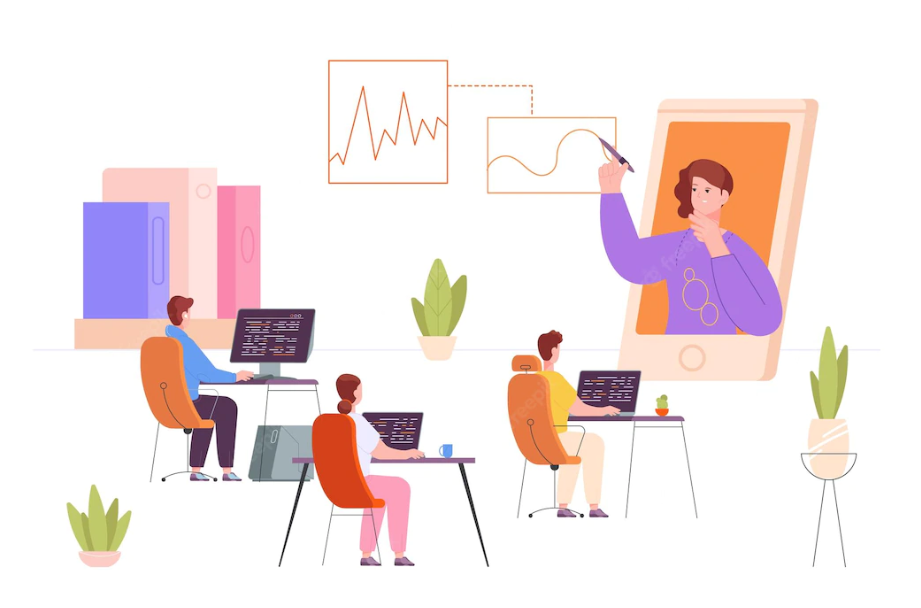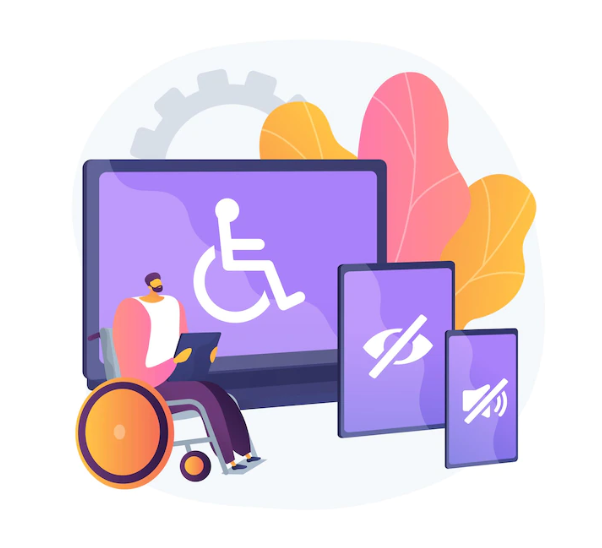
Source: freepik
Introduction
Many people with disabilities have trouble using company websites that do not comply with WCAG. To begin, if your site complies with the Web Content Accessibility Guidelines (WCAG), then it will be accessible to people with a wide range of disabilities. In addition to those with sight loss, this also includes those with other types of impairments such as hearing loss, mobility issues, or mental retardation. To add to that, conforming to WCAG standards ensures that your site is accessible to a wide range of people and includes benefits like enhanced usability, a boost in SEO metrics, and more. Assuring simple navigation, well-labeled links and buttons, and legible text are all part of this. Finally, being compliant with the WCAG can save your company from legal trouble. A customer with a disability who is unable to access your website may be able to sue you for damages if your site does not conform to the Web Content Accessibility Guidelines (WCAG).
What is WCAG (Web Content Accessibility Guidelines)?
How to make web content more accessible for individuals with disabilities is outlined in WCAG, or the Web Content Accessibility Guidelines. There are many different types of impairments that need to be considered when designing for accessibility, including those that affect sight, hearing, movement, communication, thought, language, learning, and the nervous system. These standards cover a lot of ground, but they can't possibly meet the needs of people with every possible handicap. These standards also increase the accessibility of the Web for users of all ages, making it especially helpful for users whose abilities may be diminishing with age.
With the help of people from all around the world, WCAG is created through the W3C process in order to provide a universally applicable standard for the accessibility of Web content that can be used by people of all backgrounds and by governments throughout the world. The WCAG 2.0 is an update to the original guidelines (WCAG 1.0 [WCAG10]) that aim to be universally applicable across a wide range of Web technologies, both present and future, and testable through a combination of automated and human evaluation. Accessible content is essential, but so is software that can read it, such as a web browser. The accessibility of the Web is greatly aided by authoring tools.
Importance Of WCAG For Your Website
The Web Content Accessibility Guidelines (WCAG) are a set of standards and recommendations for creating user-friendly websites. Perceivable, operable, understandable, and robust are the four guiding concepts. The creation of accessible web content relies heavily on these guidelines, therefore they aren't merely crucial. The World Wide Web Consortium is responsible for developing these widely adopted standards.
Benefits Of WCAG For Your Website
Let's take a look at the top 5 reasons why your company should prioritize web accessibility.
Enhanced usability
In addition to ensuring that people with disabilities can use your website, implementing accessibility features can greatly enhance the usability of your site and the satisfaction your visitors have while interacting with it.
Think about someone who can't use a mouse trying to utilize your website. Improving your website's accessibility by making it keyboard-navigable is a win for everyone, not just those who use assistive technologies. Long-term gains include things like increased client loyalty.
Many other suggestions exist to boost your site's usability and increase its accessibility. People with slower internet speeds will be able to get a better sense of the context of the content on your site, such as through the use of alternative text for photos.
Developing Your Brand
The separation between one's personal life and professional principles has shrunk. In business, people like to deal with those who share their values. Sixty-two percent of respondents said they are more likely to buy from a brand that makes a statement on issues, and nearly half said they would stop doing business with a company altogether if their values were at odds with theirs. We're talking about quite significant sums here.
Disabled individuals and others who fight for their rights are deeply invested in the accessibility movement. By committing to creating an accessible website, you will be broadcasting your support to the entire community. Doing so will establish your company as a go-to for disabled people. Because of this, influential people will talk well of your company.
Including an accessibility statement on your website is also recommended. Here, you can reaffirm your dedication to making your website accessible to everyone and detail the measures you've made to make it more user-friendly for persons with disabilities.
Boosts Search Engine Optimization Metrics
Having an accessible website enhances not just the user experience, but also the site's overall score, which in turn increases the website's discoverability in search engine results. That's a great way to get people to visit your website.
In layman's terms: Search engine optimization benefits from conforming to the Web Content Accessibility Guidelines.
Occasionally, a company's objectives in terms of both SEO and web accessibility will coincide. Why? Because persons with disabilities benefit from a streamlined user experience, and because a low-effort navigation structure attracts more visitors and keeps them on your site longer.
Larger Profits
Think of a huge departmental store that refuses to stock any items for left-handed customers. Not only would you be hurting the morale of the left-handed community as a whole, but you'd be passing on money.
One in four adults in the United States has a disability, as reported by the Centers for Disease Control and Prevention (including visual disabilities, hearing disabilities, motor disabilities, etc.). This constitutes a sizable portion of the general public.
As a commercial decision, accessibility improvements to your website are a no-brainer. To make your website more accessible to individuals with disabilities, you don't need to make it work for every single person who has a disability.
A shop operating in a niche but highly competitive market found that improving the usability of their website led to higher revenue per user session, more positive word of mouth, and more dedicated customers.
Avoid Getting Labeled
The Internet's popularity has skyrocketed, and it's become as essential as any other public utility. Providing disabled persons with equal access to the internet should be seen as a basic human right. The Americans with Disabilities Act (ADA) guarantees individuals with disabilities the same opportunities to participate in and benefit from government programs and services as those without disabilities.
The ADA may be read to cover the digital realm even if it does not specifically address web accessibility at this time. The U.S. Department of Justice has found that in some cases, websites that are not accessible to people with disabilities are in violation of the Americans with Disabilities Act. Businesses that fail to adhere to online accessibility guidelines may find themselves subject to discrimination allegations and subsequent legal action.

The Four Principle Accessibility Guidelines Of WCAG
The following four ideas provide the basis for the guidelines and Success Criteria, making it possible for anybody to access and use Web information. To successfully utilize the Internet, one must have content that is:
Perceivable
All data and UI elements need to be presented in a way that people can understand. Information presented to users must be perceivable by at least one of their senses for this to be the case.
Operable
The interface's buttons and menus must work. What this means is that the interface must be user-friendly. It is not acceptable for the interface to demand actions that the user is unable to complete.
Understandable
The information shown and the way the user interface functions must be easily understood. That means the content and the interface's functionality have to be easily grasped by the target audience.
Robust
The information must be robust enough to be consistently interpreted by a variety of users and online tools, including assistive devices. This indicates that consumers must continue to have access to content despite the development of new technologies. The material must continue to be accessible even as new technologies and online tools are developed.
If any of these conditions aren't met, the Internet will be inaccessible to people with impairments.
Guidelines and Success Criteria are provided under each concept to assist with implementing that principle for people with impairments. Many general usability principles exist to increase content's usability for everyone. Only the rules that directly address issues faced by individuals with disabilities have been included in WCAG 2.0. Specifically, this refers to problems that make it harder for people with impairments to use the Internet.
Conclusion
The WCAG rules can be difficult to implement without prior experience and knowledge on how to prioritize tasks. Planned website maintenance is what we offer here at Exemplifi. To keep your site up and operating smoothly and in compliance with all the necessary requirements, our team of skilled developers focuses on following the current standards and best practices. Get in touch with us today to find out how we can make your website more accessible to everyone.
